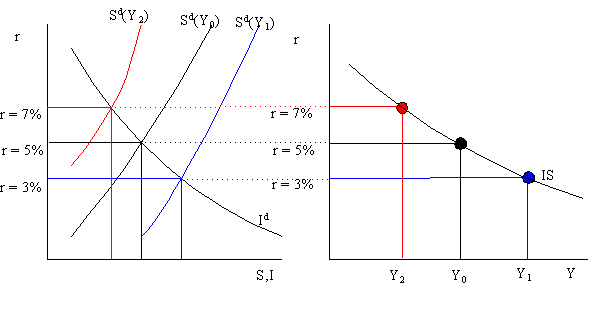
Reading: AB, chapter 10, section 2.
The IS curve represents all combinations of income (Y) and the real interest rate (r) such that the market for goods and services is in equilibrium. That is, every point on the IS curve is an income/real interest rate pair (Y,r) such that the demand for goods is equal to the supply of goods (where it is implicitly assumed that whatever is demanded is supplied) or, equivalently, desired national saving is equal to desired investment. The graphical derivation of the IS curve is given below.

Consider an initial equilibrium in the goods market where r = 5% and income is equal to Y0. This equilibrium is illustrated in the graph on the right with r on the vertical axis and Y on the horizontal axis as the big black dot (middle dot). Now suppose Y increases to Y1 (say supply increases). This increase in Y shifts the desired savings curve down and right lowering the equilibrium real interest rate to 3%. The new equilibrium in the goods market with higher income and a lower real interest rate is illustrated in the graph on the right as the big blue dot (bottom dot). Similarly, if Y decreases from Y0 to Y2 then the savings curve shifts up and left and the equilibrium real interest rises. The new equilibrium in the goods market with lower income and a higher real interest rate is illustrated in the graph on the right as the big red dot (top dot). Notice that as income increases (decreases) the real interest must fall (rise) in order to maintain equilibrium in the goods market. This is the relationship that is represented in the downward sloping IS curve.
Every point on the IS curve represents an intersection between desired national saving and desired investment for some income/interest rate pair (Y,r). As such the IS curve is derived holding the determinants of saving and investment, other than Y and r, fixed. When these factors change the IS curve will shift. Since points on the IS curve represent points where aggregate demand is equal to aggregate supply any factor that increases the demand for goods and services will shift the IS curve up and to the right and any factor that decreases the demand for goods and services will shift the IS curve down and to the left. From the savings/investment diagram it follows that any shift of the savings or investment curve that increases the real interest rate, holding Y fixed, will shift up the IS curve. Functionally, the IS curve is represented as

Pluses (+) above the exogenous variables indicate that increases in the variables shift the IS curve up and to the right (increases demand).
[Next Slide] [Previous Slide] [Contents for Lecture 8] [Slides from Lecture] [301 Homepage]
Last updated on July 31, 1996 by Eric Zivot.